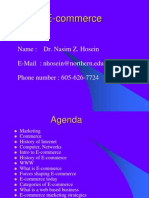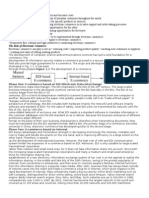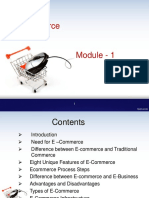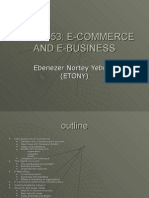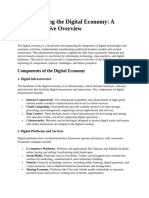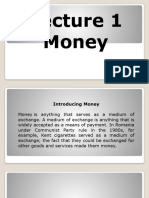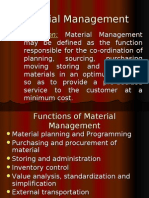0 ratings0% found this document useful (0 votes)
21 viewsChapter 10
Chapter 10
Uploaded by
Samit ShresthaThe document discusses key aspects of the digital economy, including its 12 themes and 10 technology shifts. It outlines the components that make up the digital economy, such as government, infrastructure, industries, and intellectual property. It also describes the four layers that indicate the internet economy: internet infrastructure, applications infrastructure, intermediaries, and commerce. Overall, the document provides an overview of the digital/internet economy, its defining characteristics, and important factors that comprise it.
Copyright:
© All Rights Reserved
Available Formats
Download as PPTX, PDF, TXT or read online from Scribd
Chapter 10
Chapter 10
Uploaded by
Samit Shrestha0 ratings0% found this document useful (0 votes)
21 views23 pagesThe document discusses key aspects of the digital economy, including its 12 themes and 10 technology shifts. It outlines the components that make up the digital economy, such as government, infrastructure, industries, and intellectual property. It also describes the four layers that indicate the internet economy: internet infrastructure, applications infrastructure, intermediaries, and commerce. Overall, the document provides an overview of the digital/internet economy, its defining characteristics, and important factors that comprise it.
Original Description:
chapter 10 spm
Copyright
© © All Rights Reserved
Available Formats
PPTX, PDF, TXT or read online from Scribd
Share this document
Did you find this document useful?
Is this content inappropriate?
The document discusses key aspects of the digital economy, including its 12 themes and 10 technology shifts. It outlines the components that make up the digital economy, such as government, infrastructure, industries, and intellectual property. It also describes the four layers that indicate the internet economy: internet infrastructure, applications infrastructure, intermediaries, and commerce. Overall, the document provides an overview of the digital/internet economy, its defining characteristics, and important factors that comprise it.
Copyright:
© All Rights Reserved
Available Formats
Download as PPTX, PDF, TXT or read online from Scribd
Download as pptx, pdf, or txt
0 ratings0% found this document useful (0 votes)
21 views23 pagesChapter 10
Chapter 10
Uploaded by
Samit ShresthaThe document discusses key aspects of the digital economy, including its 12 themes and 10 technology shifts. It outlines the components that make up the digital economy, such as government, infrastructure, industries, and intellectual property. It also describes the four layers that indicate the internet economy: internet infrastructure, applications infrastructure, intermediaries, and commerce. Overall, the document provides an overview of the digital/internet economy, its defining characteristics, and important factors that comprise it.
Copyright:
© All Rights Reserved
Available Formats
Download as PPTX, PDF, TXT or read online from Scribd
Download as pptx, pdf, or txt
You are on page 1of 23
Chapter-10
Thrive in a new economy
Digital Economy
• Digital economy refers to an economy that is based on digital
computing technologies, although we increasingly perceive this as
conducting business through markets based on the internet and the
World Wide Web. The digital economy is also sometimes called the
Internet Economy, New Economy, or Web Economy.
Component of Digital Economy
1. Government
2. Policy and regulation
3. Infrastructure- Internet and electricity
4. Telecommunication industry
5. Digital service providers
6. E-business and e-commerce industry
7. Information and knowledge management systems
8. Intellectual property rights
9. Human capital and knowledge workers
10. Research and development
11. Emerging technologies
Twelve theme of the Digital economy
• Knowledge
• Digitization
• Virtualization
• Molecularization
• Integration / Internetworking
• Disintermediation
• Convergence
• Innovation
• Presumption
• Immediacy
• Globalization
• Discordance
1. Knowledge
• Information Technology enables an economy based on knowledge
• Economy based on brain rather than brawn
• Rise of Artificial Intelligence (AI) and other knowledge technologies
• Knowledge is created by knowledge workers and by knowledge
customers
2. Digitization
• All information can be represented as either 1 or 0
• Bits could be used to represent more and more types of information,
such as graphs and photographs
• Vast amounts of information can be squeezed or compressed and
transmitted at the speed of light.
3. Virtualization
• As information shifts from analog to digital, physical things can
become virtual – changing the metabolism of the economy, the types
of institutions and relationships possible, and the nature of economic
activity itself.
• Few examples of virtualization are virtual shopping mall, virtual
corporation.
4. Molecularization
• The old corporation is being disaggregated.
• Replaced by dynamic molecules and clusters of individuals and
entities that form the basis of economic activity.
• Mass becomes molecular (based on the individual) in all aspects of
economic and social life.
5. Integration/Internetworking
• Integration molecules into clusters that network with others for the
creation of wealth
• Internet worked Enterprise
• Networking from host computer
6. Disintermediation
• Middleman functions between producers and consumers are being
eliminated through digital networks; e-commerce
• Changing the single pattern.
• For instance: Musicians and their producers won’t need recording
companies, retail outlets, or broadcasters when their music becomes
a database entry on the Net.
7. Convergence
• In the new economy the dominant economic sector is being created
by three converging industries computing, communications and
content that in turn provide the infrastructure for wealth creation by
all sectors.
8. Innovation
• The new economy is an innovation-based economy. It is the key driver
of economic activity and business success. Rather than traditional
drivers of success such as access to raw materials, production, and
cost of labor human imagination becomes the main source of value.
9. Presumption
• The gap between consumers and producers blurs
• Mass production is replaced by mass customization
• Producers must create specific product that reflect the requirements
and tastes of individual customers.
• Consumers are involved in the actual production process
10. Immediacy
• The new economy is a real-time economy.
• Commerce becomes electronic as business transactions and
communications occur at the speed of light.
11. Globalization
• The new economy is a global economy. As Peter Drucker says,
“Knowledge knows no boundaries”.
• There is no domestic knowledge or no international knowledge.
• The office is no longer a place; it is a global system.
• The technology is eliminating the “place” in workplace.
12. Discordance
• Unpredicted social issues such as; privacy, access, quality of work life,
quality of life etc. are beginning to arise
• The nature of work and the requirements of the workforce in the
digital economy are fundamentally different
• The new economy is bringing high-paid, high-value jobs, but there is
little job mobility between old and new
The ten technology shift
1. From Analog to Digital
2. From Traditional semi-conductor to Microprocessor Technology
3. From Host to client / server computing
4. From Garden Path Bandwidth to Information Gateway
5. From Dumb Access Device to Information Application
6. From separate data, text, voice and image to multi-media
7. From Proprietary to open system
8. From Dumb to Intelligent Network
9. From Craft to Object Computing
10.From GUI’s to VR
The Internet Economy and its indicators
• Layer 1: Internet Infrastructure
• Layer 2: Internet and Network Applications Infrastructure
• Layer 3: Internet Intermediary
• Layer 4: Internet Commerce
Layer 1: Internet Infrastructure
• Companies that manufacture or provide products and services that
make up the Internet network infrastructure includes:
• Internet backbone providers
• Internet service providers
• Networking hardware and software companies
• PC and Server manufacturers
Layer 2: Internet and Network Applications
Infrastructure
• Companies that manufacture or provide products and services
necessary to carry out all activities in the digital market includes:
• Internet consultants
• Web server software and other Internet applications
• Multimedia applications
• Web development software
• Search engine software
• Online training
Layer 3: Internet Intermediary
• Companies that increase the efficiency of electronic markets by
facilitating the meeting and interaction of buyers and sellers via the
World Wide Web and Internet includes:
• Market makers in vertical industries
• Online travel agents
• Online brokerages
• Content aggregators
• Portals/Content providers
• Internet ad brokers
Layer 4: Internet Commerce
• Companies that generate product and service sales to consumers or
businesses over the Internet and World Wide Web.
• Online product sales
• Fee/subscription-based companies
• Online advertising
• Online travel providers
E-commerce and Digital Economy
You might also like
- BSBLDR812 Project Portfolio AssignmentDocument17 pagesBSBLDR812 Project Portfolio AssignmentSamit Shrestha100% (1)
- Vertigo Pricing ModelingDocument2 pagesVertigo Pricing ModelingRodrigo Perez100% (1)
- Review - CHAPTER 1 The Revolution Is Just BeginningDocument4 pagesReview - CHAPTER 1 The Revolution Is Just BeginningNguyện ÝNo ratings yet
- What Is ServiceDocument10 pagesWhat Is ServiceHomi NathNo ratings yet
- New Microsoft Word DocumentDocument13 pagesNew Microsoft Word DocumentSubhan Ali0% (1)
- Eic Unit 10Document36 pagesEic Unit 10evanjames038No ratings yet
- The Twelve Themes of The New Economy: A Consumer Active in A Product's and ProductionDocument9 pagesThe Twelve Themes of The New Economy: A Consumer Active in A Product's and ProductionAnand Kumar BhagatNo ratings yet
- U1 DBM Digital Economy - IntroDocument20 pagesU1 DBM Digital Economy - Intro15 Sai KiranNo ratings yet
- Digital Business PPT CH - 1Document86 pagesDigital Business PPT CH - 1Chirag PatilNo ratings yet
- 5DBM Digital Economy - IntroDocument20 pages5DBM Digital Economy - IntrokhaitalapurampallaviNo ratings yet
- E Commerce Class 1 07.12.2024Document12 pagesE Commerce Class 1 07.12.2024nishantsshukla92No ratings yet
- E-Commerce: Name: Dr. Nasim Z. Hosein E-Mail: Nhosein@northern - Edu Phone Number: 605-626-7724Document110 pagesE-Commerce: Name: Dr. Nasim Z. Hosein E-Mail: Nhosein@northern - Edu Phone Number: 605-626-7724Shubham GoyalNo ratings yet
- E-Commerce: Name: Dr. Nasim Z. Hosein E-Mail: Nhosein@northern - Edu Phone Number: 605-626-7724Document110 pagesE-Commerce: Name: Dr. Nasim Z. Hosein E-Mail: Nhosein@northern - Edu Phone Number: 605-626-7724Siddharth NayakNo ratings yet
- Arsi University College of Business & Economics Department of Logistics & Supply Chain ManagementDocument21 pagesArsi University College of Business & Economics Department of Logistics & Supply Chain Managementassefa horaNo ratings yet
- E - Marketing RevDocument53 pagesE - Marketing Revabdelamuzemil8No ratings yet
- Introduction To E-Commerce: Dr. Noman IslamDocument28 pagesIntroduction To E-Commerce: Dr. Noman IslammoazzamNo ratings yet
- Unit-I Electronic Commerce Environment and Opportunities 1.backgroundDocument14 pagesUnit-I Electronic Commerce Environment and Opportunities 1.backgroundPriyadarshini PatilNo ratings yet
- Chapter5 Info SystemsDocument24 pagesChapter5 Info SystemsyhfucaNo ratings yet
- The Internet and WWWDocument50 pagesThe Internet and WWWzawayarobert45No ratings yet
- Module 3 THE DIGITAL AND SOCIAL WORLDS ECONOMY, ENTERPRISES, AND SOCIETYDocument33 pagesModule 3 THE DIGITAL AND SOCIAL WORLDS ECONOMY, ENTERPRISES, AND SOCIETYLeighann MeerNo ratings yet
- E-Commerce FundamentalsDocument30 pagesE-Commerce FundamentalsShruti SinghNo ratings yet
- Chapter 1 PPT UpdatedDocument26 pagesChapter 1 PPT UpdatedKashif AliNo ratings yet
- Unit 1Document45 pagesUnit 1sinmayank31No ratings yet
- Introduction To E-BusinessDocument32 pagesIntroduction To E-BusinessrutujachoudeNo ratings yet
- Evolution of E-CommerceDocument16 pagesEvolution of E-CommerceDarshan PatilNo ratings yet
- Advantages of Electronic Commerce: Phase One: E-Commerce Based On EDI (Electronic Data Interchange)Document6 pagesAdvantages of Electronic Commerce: Phase One: E-Commerce Based On EDI (Electronic Data Interchange)ram_somalaNo ratings yet
- Digital TransformationDocument77 pagesDigital TransformationRASHNo ratings yet
- Ch1. Introduction to E-commerceDocument12 pagesCh1. Introduction to E-commerceragragraghadNo ratings yet
- Principles of Information Systems Eighth Edition: Electronic and Mobile CommerceDocument21 pagesPrinciples of Information Systems Eighth Edition: Electronic and Mobile CommerceHope..!No ratings yet
- Unit 1Document15 pagesUnit 1peter77No ratings yet
- 5 6057621431896770582Document6 pages5 6057621431896770582aruproy.aaNo ratings yet
- Introduction To E-CommerceDocument40 pagesIntroduction To E-CommerceSushma NaiduuNo ratings yet
- E-Commerce and E-Business: E-Commerce (EC) : Electronic Commerce Encompasses The Entire Online Process ofDocument3 pagesE-Commerce and E-Business: E-Commerce (EC) : Electronic Commerce Encompasses The Entire Online Process ofSabbir Zaman100% (1)
- ECommerce - Module IDocument9 pagesECommerce - Module IsmritisambitNo ratings yet
- ISM Unit-8Document112 pagesISM Unit-8nandini swamiNo ratings yet
- EconomyDocument3 pagesEconomynpq189No ratings yet
- Management Information SystemDocument35 pagesManagement Information SystemSumeda PriyanjithNo ratings yet
- Electronic Commerce - Technology and Prospects: HapteDocument23 pagesElectronic Commerce - Technology and Prospects: HapteDeepali DeshpandeNo ratings yet
- Basic E Commerce ConceptsDocument21 pagesBasic E Commerce ConceptsRalph Renz SansonNo ratings yet
- Introduction To E-Business: BBA VIII SemesterDocument20 pagesIntroduction To E-Business: BBA VIII Semesterroshan kcNo ratings yet
- Lecs2.ppt - PPT 2Document22 pagesLecs2.ppt - PPT 2Huda ElMaghrabyNo ratings yet
- Chapter-1 Power Point E-CommerceDocument18 pagesChapter-1 Power Point E-CommerceYaikob MaskalaNo ratings yet
- E CommerceDocument109 pagesE CommerceAkhil Mathew PhilipNo ratings yet
- Chapter 10 E-COMMERCE DIGITAL MARKETS, DIGITAL GOODSDocument40 pagesChapter 10 E-COMMERCE DIGITAL MARKETS, DIGITAL GOODSAbdinor Abukar AhmedNo ratings yet
- Digital Economy Refers To An Economy That Is Based On Digital Computing Technologies. Internet Economy/New Economy/ Web EconomyDocument12 pagesDigital Economy Refers To An Economy That Is Based On Digital Computing Technologies. Internet Economy/New Economy/ Web EconomyKrishna ChaitanyaNo ratings yet
- Session 1 Digital EconomyDocument16 pagesSession 1 Digital EconomyPathumini PereraNo ratings yet
- E-Commerce Bit All Modules FullDocument4 pagesE-Commerce Bit All Modules FullRasna PNo ratings yet
- Review: TherevolutionisjustbeginningDocument3 pagesReview: TherevolutionisjustbeginningahmedmsarkhiNo ratings yet
- Concepts of New Economy: Outcome 4Document9 pagesConcepts of New Economy: Outcome 4jpaladi.2014No ratings yet
- E-Commerce: Digital Markets, Digital GoodsDocument29 pagesE-Commerce: Digital Markets, Digital GoodsHassan YassinNo ratings yet
- Introduction To Information and Communication Technology: Lecture 11: E-CommerceDocument24 pagesIntroduction To Information and Communication Technology: Lecture 11: E-Commerceusman sheikhNo ratings yet
- Ecomm BitDocument4 pagesEcomm Bitsharanraj037840No ratings yet
- E-commerce_Sessions 1-7Document80 pagesE-commerce_Sessions 1-7bilaalrashid2006No ratings yet
- E-Commerce Concept and PlatformsDocument26 pagesE-Commerce Concept and PlatformsProgram Bersama PPSWNo ratings yet
- E-Commerce and Its Business ModelDocument95 pagesE-Commerce and Its Business Modeleyedol97% (67)
- Understanding The Digital EconomyDocument5 pagesUnderstanding The Digital Economydharma.halim.adl2No ratings yet
- 10 Tech ShiftsDocument18 pages10 Tech ShiftsKushalta DhungelNo ratings yet
- Introduction To E-CommerceDocument28 pagesIntroduction To E-CommerceFlorence ReyesNo ratings yet
- Keeping the Digital Simple: A Handbook for Telco Digital TransformationFrom EverandKeeping the Digital Simple: A Handbook for Telco Digital TransformationRating: 4 out of 5 stars4/5 (1)
- BSBINS603 Project Portfolio Section 1 v21.1Document12 pagesBSBINS603 Project Portfolio Section 1 v21.1Samit ShresthaNo ratings yet
- Chapter 8Document22 pagesChapter 8Samit ShresthaNo ratings yet
- EIC Unit 5Document23 pagesEIC Unit 5Samit ShresthaNo ratings yet
- EIC Unit 7Document29 pagesEIC Unit 7Samit ShresthaNo ratings yet
- SPM ReportDocument12 pagesSPM ReportSamit ShresthaNo ratings yet
- A Study On Future Marketing Trends Indian Cement IndustryDocument3 pagesA Study On Future Marketing Trends Indian Cement IndustryLokesh SharmaNo ratings yet
- Principles of LendingDocument2 pagesPrinciples of LendingWaqas TariqNo ratings yet
- We Om 120081Document6 pagesWe Om 120081Kiko HuitNo ratings yet
- The Future of Oil and Gas Business: Development of Local Content in Mozambique post-COVID-19Document11 pagesThe Future of Oil and Gas Business: Development of Local Content in Mozambique post-COVID-19manuel machavaNo ratings yet
- International Human Resources ManagementDocument29 pagesInternational Human Resources ManagementJugal KeshwalaNo ratings yet
- Labor Advisory No. 4Document3 pagesLabor Advisory No. 4Kaye Dominique Tono100% (1)
- Menimbang Daya Saing Pariwisata Indonesia (Dibandingkan Singapura, Malaysia, Dan Thailand)Document22 pagesMenimbang Daya Saing Pariwisata Indonesia (Dibandingkan Singapura, Malaysia, Dan Thailand)Vira Amalina ShafiraNo ratings yet
- Download Full Sustainable Value Creation 2nd Edition Chandler PDF All ChaptersDocument52 pagesDownload Full Sustainable Value Creation 2nd Edition Chandler PDF All Chapterskombatchabez100% (3)
- Marketing Strategy of K-BeautyDocument8 pagesMarketing Strategy of K-BeautyMahmudul_Islam_duNo ratings yet
- Al CorporationDocument3 pagesAl CorporationMatovu23 Sharif23No ratings yet
- Difference Between Job Work and CareerDocument4 pagesDifference Between Job Work and CareerFatima EzzahraNo ratings yet
- Gen Math: AnnyeongDocument16 pagesGen Math: AnnyeongZaldy Emmanuel MendozaNo ratings yet
- HUL FinancialsDocument5 pagesHUL FinancialstheNo ratings yet
- Financial Liabilities SummaryDocument4 pagesFinancial Liabilities SummaryNancy Litera MusicoNo ratings yet
- 01 A AI Letter To Branch Management pg1-18Document18 pages01 A AI Letter To Branch Management pg1-18Nitesh kumarNo ratings yet
- VRIO Framework - Group 13 - Section DDocument15 pagesVRIO Framework - Group 13 - Section DMainali GautamNo ratings yet
- Hieu Nguyen Cutting Through The Fog-Case OverviewDocument2 pagesHieu Nguyen Cutting Through The Fog-Case OverviewHiếu Nguyễn Minh HoàngNo ratings yet
- MPCBDocument30 pagesMPCBJohn Mark CabrejasNo ratings yet
- Jevette Final Business PlanDocument6 pagesJevette Final Business PlanJustine GonzalesNo ratings yet
- Final JS Bank) AzharDocument57 pagesFinal JS Bank) Azharhafeez ahmedNo ratings yet
- Tax Investment StrategyDocument7 pagesTax Investment StrategysinghbabaNo ratings yet
- Material ManagementDocument18 pagesMaterial Managementgayatri_vyas1No ratings yet
- FlashloansDocument15 pagesFlashloansPerpetual God100% (1)
- Horizontal Income Statement and Balance SheetDocument7 pagesHorizontal Income Statement and Balance SheetSourabh RathiNo ratings yet
- Reynolds Group 2009 Annl Report - 20170223T084641.289161Z PDFDocument378 pagesReynolds Group 2009 Annl Report - 20170223T084641.289161Z PDFblombardi8No ratings yet
- Permanent TSB Personal and Business Banking ChargesDocument22 pagesPermanent TSB Personal and Business Banking ChargesArturo MolinaNo ratings yet
- Santej 4Document5 pagesSantej 4Mahendra ShahNo ratings yet
- Invoice 18Document1 pageInvoice 18kuldeep singhNo ratings yet
- An Introduction To Bangladesh StudiesDocument23 pagesAn Introduction To Bangladesh StudiesAzmol HossainNo ratings yet













